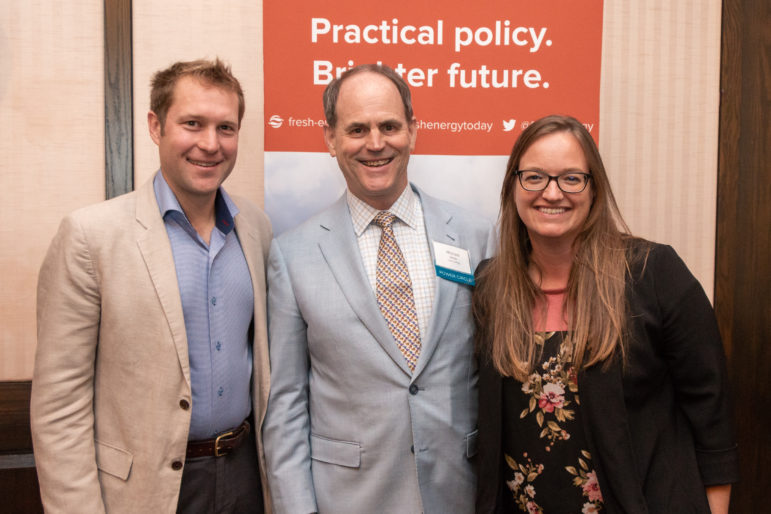
As more ground-mounted solar sites spring up in Minnesota, it’s creating new opportunities to plant the land under the panels with deep-rooted vegetation— providing pollinator habitat and improving water quality, crop yields, and soil health. Though early solar projects were designed with turfgrass or gravel, pollinator-friendly seed mixes are rapidly becoming more common.
On May 17, Fresh Energy held a public event with more than 200 concerned people, including leaders from agriculture, water, solar, engineering, conservation, and local government for a conversation on why and how we can accelerate the use of pollinator-friendly habitat on solar sites to make it ‘business-as-usual.’ The event, titled Good Energy, was part of Fresh Energy’s popular Power Pairings series that engages two prominent leaders for a conversation about our energy future.
Rob Davis, Director of Fresh Energy’s new Center for Pollinators in Energy, kicked off the Good Energy Power Pairing event, introducing two experts with unique perspectives on this issue: Clare Lindahl, CEO of the Soil and Water Conservation Society and Jordan Macknick, a national energy-water-land expert at the National Renewable Energy Laboratory (NREL).
A self-proclaimed saleswoman for conservation, Clare explained the many advantages of pairing pollinator habitat with solar installations. Dense, deep vegetation holds soils in place preventing erosion, she said, and areas planted with pollinator habitat and native grasses also filter water—soaking it up like a sponge—which helps protect against floods.
Clare also shared her insights on the economic benefits for farmers that use parts of their land for solar, helping farmers diversify their operating expenses and insulating them from the variability of the commodity market. Further, she emphasized that in order to restore and maintain the population of honey bees and native bees, we need to implement pollinator habitat practices on private lands. With significant growth in solar on the horizon, solar lands can be those crucial private lands that tip the balance on habitat as well as improve water quality and soil health.
NREL’s Jordan Macknick highlighted his research on pollinator-friendly solar at the nation’s premier research facility for evaluating renewable energy technology. Jordan is leading a multi-year, multi-state, multi-configuration project to develop quantitative data for the costs and benefits of pollinator habitat at solar sites, specifically on agriculture.
He told the crowd that to date, his findings indicate that while installing pollinator habitat can cost a little more money upfront, it saves money in the long run. Pollinator-friendly plantings do not need to be mowed as frequently as turf grass, and data show that having vegetation rather than gravel under the solar panels increases solar performance by creating a cooler microclimate leading to higher energy output and efficiency. Jordan also shared that NREL is about to publish a study that shows that as of today, there are tens of thousands of acres of existing pollinator dependent crops growing within one mile of a solar project. These crops would have benefit if that solar project had been designed and seeded to be pollinator-friendly.
Both speakers emphasized Minnesota’s nation-leading progress on pollinator-friendly solar and the clear economic and environmental benefits. The event’s moderated conversation included many strategies for expanding implementation of this practice. In the end Clare emphasized the sociological and cultural aspects of change, as well as the importance of communicating the value of pollinator-friendly solar and highlighting projects that are done right. “We need to shine a light on inspirational stories that work to give folks the confidence they need,” she said.
For a full recording of the event see below.
Fresh Energy is optimistic about the future of pollinator-friendly solar and has worked hard to build momentum for the strategy. In 2016 Fresh Energy, Audubon Minnesota, the Minnesota Farmers Union, and the Minnesota Corn Growers worked with agricultural and business leaders to establish the nation’s first statewide standard for the vegetation that grows under and around large ground-mounted solar sites. With bipartisan lead authors, the “Pollinator-Friendly Solar Act” passed unanimously as part of the 2016 Agriculture Omnibus bill. Today, there are pollinator-friendly solar arrays, based on these scorecards, completed or in the works, in Minnesota, Wisconsin, Illinois, Colorado, North Dakota, Iowa, Ohio, Nebraska, Vermont, New York, Virginia, Maryland, North Carolina, Georgia, Texas, and Oregon.
Fresh Energy thanks all who made the May Good Energy Power Pairing event a success. Stay tuned for updates on our progress toward making pollinator habitat on solar installations ‘business as usual’ in Minnesota and across the country.
For questions about Fresh Energy’s Center for Pollinators in Energy contact Rob Davis at davis@fresh-energy.org or 651 726 7565.
